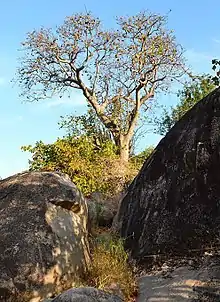| Sterculia africana | |
|---|---|
 | |
| S. africana taken in Namaso Bay, Southern Lake Malawi. | |
| Scientific classification | |
| Kingdom: | Plantae |
| Clade: | Tracheophytes |
| Clade: | Angiosperms |
| Clade: | Eudicots |
| Clade: | Rosids |
| Order: | Malvales |
| Family: | Malvaceae |
| Genus: | Sterculia |
| Species: | S. africana |
| Binomial name | |
| Sterculia africana | |
| Synonyms | |
|
Triphaca africana Lour. | |
Sterculia africana[2] or African star-chestnut is a deciduous tree, belonging to the genus Sterculia and the family Malvaceae (previously the Sterculiaceae, now relegated to a subfamily).[3] The species is sometimes called the "mopopaja tree". It is distributed throughout Northeast Africa to Arabia.
Description
Sterculia africana is a deciduous tree that grows up to 8m tall, it is monoecious, with a single trunk and rounded crown. S.africana has smooth and flaking bark that is grey or pinkish brown. The leaves alternate, crowded at the ends of branches, orbicular, 8–15 cm long x 8–15 cm across. Leaves are 3-5 lobed and covered in stellate hairs. Flowers appear before the leaves 1.5–2 cm across, in axillary panicles. Flowers are unisexual with both sexes being found on the same tree. They have no petals, but the calyx is coloured and functions as a corolla. In the male flowers the numerous anthers are fused together to form a column. The fruits consist of 3-5 spreading, ovoid lobes which split at maturity and are covered with dense golden hairs. The inside surface of the lobes contain small stinging hairs.[4]
Stercula africana sheds its leaves during the dry season and comes into flower before the leaves reappear at the start of the monsoon. Small quantities of resin ooze from the bark of the trunk and larger branches.[5]
Distribution and habitat
Sterculia africana has been recorded in southeastern Egypt, Eastern Sudan, Ethiopia, Djibouti, northern Somalia, southern Tanzania, Mozambique, Malawi, eastern Zambia, Zimbabwe, Botswana, and Namibia's Caprivi Strip.[6] No subspecies are listed in the Catalogue of Life.[3] Variety socotrana is endemic to the island of Socotra.[7]
Sterculia africana grows in dry woodlands on limestone escarpments and the sides of wadis[7] usually at elevations of below 600m.[8]
Uses
Resin was traditionally used as a washing agent in Arabia. The hardened resin was mixed with water or spittle and then rubbed over the body. It was also a treatment to treat head lice. It is an important fodder and the wood was used to make fishing platforms.[5]
Threats
The current population is stable however as it is an important fodder for cattle, if the livestock populations increase, the tree would come under increasing threat.[7]
Gallery
References
- ↑ Botanic Gardens Conservation International (BGCI).; IUCN SSC Global Tree Specialist Group (2019). "Sterculia africana". IUCN Red List of Threatened Species. 2019: e.T62754A146209124. doi:10.2305/IUCN.UK.2019-2.RLTS.T62754A146209124.en. Retrieved 11 November 2021.
- ↑ Fiori, 1912 In: Agric. Colon., It., 5: Suppl., 37 [1911]
- 1 2 Roskov Y.; Kunze T.; Orrell T.; Abucay L.; Paglinawan L.; Culham A.; Bailly N.; Kirk P.; Bourgoin T.; Baillargeon G.; Decock W.; De Wever A. (2014). Didžiulis V. (ed.). "Species 2000 & ITIS Catalogue of Life: 2014 Annual Checklist". Species 2000: Reading, UK. Retrieved 25 August 2017.
- ↑ "Sterculia africana in Global Plants on JSTOR". plants.jstor.org. Retrieved 2018-03-17.
- 1 2 G., Miller, Anthony (1988). Plants of Dhofar, the southern region of Oman : traditional, economic, and medicinal uses. Morris, Miranda., Stuart-Smith, Susanna., Oman. Office of the Adviser for Conservation of the Environment. [Muscat]: Prepared and published by the Office of the Adviser for Conservation of the Environment, Diwan of Royal Court, Sultanate of Oman. p. 280. ISBN 0715708082. OCLC 20798112.
{{cite book}}: CS1 maint: multiple names: authors list (link) - ↑ "Flora of Zimbabwe: Species information: Sterculia africana". www.zimbabweflora.co.zw. Retrieved 2018-03-17.
- 1 2 3 Miller, A. (2004). "Sterculia africana var. socotrana". IUCN Red List of Threatened Species. 2004: e.T33688A9797187. doi:10.2305/IUCN.UK.2004.RLTS.T33688A9797187.en. Retrieved 11 November 2021.
- ↑ "Sterculia africana - Useful Tropical Plants". tropical.theferns.info. Retrieved 2018-03-17.
External links
 Media related to Sterculia africana at Wikimedia Commons
Media related to Sterculia africana at Wikimedia Commons Data related to Sterculia africana at Wikispecies
Data related to Sterculia africana at Wikispecies




.jpg.webp)